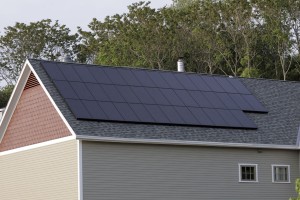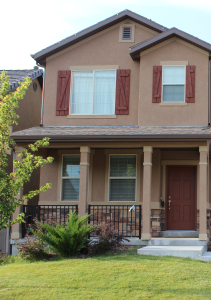(skip to the bottom of the post for the Home Solar Panels: TL;DR)
Last year I almost bought a full-house solar system that would replace my current electricity bill while generating an immediately positive cash flow along with a good amount of equity. I was so excited to be able to find an economically sensible way to install home solar panels, but our family soon found out that Homeowners Associations (HOAs) and many lobbied public interests have no desire to make solar projects easy. The biggest blocker for us was the HOA decided to strictly interpret its so-called solar provisions to only include panels that were installed flush with the roof. This was next to impossible without entirely rebuilding the roof. I thought my solar ambitions were dead in the water…
We had a south-facing lot, which the HOA didn’t want. We wanted to install a lot of panels, which the HOA didn’t want. It seemed like we were in a no-win scenario. That is until I recently came across a type of solar panel that installed like a roofing shingle, completely flush with the roof and extremely dark in color all around.
The Amorphous-silicon photovoltaic laminate panels are about half as efficient the traditional mono- or poly-crystalline panels you see on most rooftops, but its shortcomings are quickly overcoming by its thinness, flexibility, and overall durability. It handles high temperatures better and cannot be easily seen from the street due to its low profile. In fact, when I submitted a picture example of the solar panel on my porch roof to the HOA, they didn’t even realize a panel was on the roof. They asked me to submit a picture of the solar panel installed on a roof. See if you can find it, I promise it’s there:
So instead of installing a whole-house system, the initiative morphed into a emergency power plant. First, I installed one 144-Watt Uni-solar thin-film panel and ran the lines to a small grid-tie inverter, which started putting power back on to the grid through a standard wall outlet. I measure the power input through a standard Kill-A-Watt outlet power meter. Most people use it to measure the power draw that certain appliances use, but the standard Kill-A-Watt meter is also bi-directional.
After putting a little chunk of power back on to the grid, I added a small 10-Amp MPPT charge controller to the circuit via parallel wiring to charge the emergency backup batteries I was going to use in this system. Little did I realize that this would be the most expensive part of the system. I bought some huge deep-cycle AGM batteries, hooked them up to the charge controller in a 12-volt parallel array and finally had a small power plant that could run the refrigerator or furnace for a few days.
At the very least, this whole project gave me a big appreciation and better understanding of how solar power works. With this setup, my solar panels will keep the emergency batteries charged, and any excess juice will go directly back onto the grid. I did not go with a net metering service from the local power company because I would’ve been charged $4 a month just to use the service, and my system was not powerful enough to make it worth it. As long as you are never generating more power than you are currently consuming (and I easily consume 144 Watts at all times of the day), it makes no sense to install a net meter because your in-home appliances will consume that extra energy before it goes out onto the grid.
Home Solar Panels: TL;DR
If you go with a small emergency power backup solar system, don’t buy in to the net metering service. Here is the final list of products used:
- 1 – 144-Watt PVL solar panel
- 1 – 10-Amp MPPT charge controller
- 1 – 300W grid-tie power inverter
- 2 – 50-ft 10-AWG solar cable
- 3 – 155-Amp-hour 12-volt AGM deep-cycle batteries
Have a question about my setup or other learnings? How about MPPT vs PWM charge controllers? Or standard lead-acid vs. AGM batteries? Leave me a comment below and I’ll be happy to answer whatever I can.





Is it possible to power the refrigerator and furnace that you mentioned when the power goes out? Do you have a separate inverter for that?
Yes, I have a separate power inverter I can activate to directly power the furnace/refrigerator If the power goes out. It’s not automatic switchover, but it works well enough for my purposes.
Last I had heard you were at the no-win situation. So glad you found a solution! Fun to read about.
Yeah… that’s probably how I would do it too. If I’m looking at the right battery, it seems like it can deliver about (12v * 155Ah) = 1860W*h. Maybe enough for 10-30 minutes on an electric furnace. Does that sound right? You could probably keep a refrigerator/freezer running for quite a while.
Danielle Eaton Hart liked this on Facebook.
Erin N Charles Humphreys liked this on Facebook.
Christopher Madsen liked this on Facebook.
Chris, to clarify, it’s meant to run the blower on my gas furnace when the power goes out. From what I can tell, this system could run the blower for a very long time.
Kristen Mensinger Hansen liked this on Facebook.
what was the cost you estimated for the full house system your HOA denied? I’m really curious about that. I don’t have an HOA right now…but I think I might in the next few years!
About $23k total before the federal and state tax credits (which help saves about 33%).
really?? hmm….that’s a lot less than I thought.
We only needed a 5kW system for our needs. Your mileage may vary.
Matthew Paxman liked this on Facebook.
Christy Perkins liked this on Facebook.
Suzanna Tanner Nielson liked this on Facebook.
Nelson Barber liked this on Facebook.
Nemy Ramos liked this on Facebook.
Brian Topham
This is really intriguing. Do you have any ballpark estimate on what you’ll end up saving per month, and does the power company just give you a credit for what goes back into the grid?
If I had gone with a full house system, I would’ve immediately saved 30% on my normal power bill until the system was paid off. Then it would’ve been all positive gains from there. However, since I went with only an emergency backup system, I will only save a small amount of money on the monthly bill. Most power companies just credit you for whatever ends up on the grid.
Interesting…I literally just bought a house yesterday, and I keep finding myself pondering a solar panel setup haha…maybe a similar setup would be a good starting point.
Sam Elder liked this on Facebook.
Sam Elder liked this on Facebook.
Nemy Ramos liked this on Facebook.
Christy Perkins liked this on Facebook.
Suzanna Tanner Nielson liked this on Facebook.
Nelson Barber liked this on Facebook.
Matthew Paxman liked this on Facebook.
Kristen Mensinger Hansen liked this on Facebook.
Danielle Eaton Hart liked this on Facebook.
Erin N Charles Humphreys liked this on Facebook.
Christopher Madsen liked this on Facebook.
Dear Hai Tech Eric:
Where did you buy your 115 W flex solar panels? I bought some at a garage sale and cant find the manufacturer nor the wattage. But they look just like the one in your picture. My panels are each 4 ft wide and 18 foot long.
I bought the 144 W panel off of Amazon, but they appear to be out of stock right now. I’m not sure if they are even produced anymore, but they were made by Unisolar. http://www.amazon.com/gp/product/B003ZZLW68/ref=as_li_tl?ie=UTF8&camp=1789&creative=390957&creativeASIN=B003ZZLW68&linkCode=as2&tag=haifamblo-20&linkId=44JGJ4TDKMLM45C4
Rudi,
Here is a link to other Unisolar panels that are still in stock: http://amzn.to/1WWIv1b